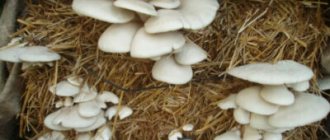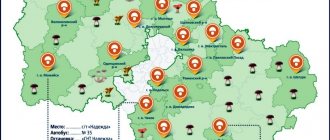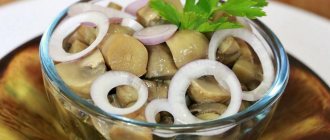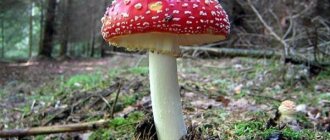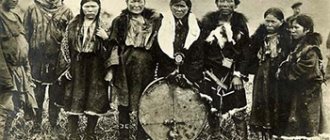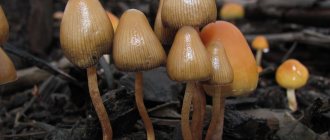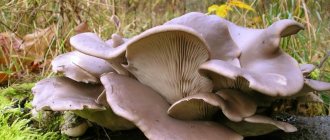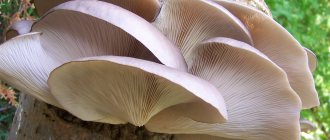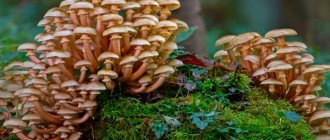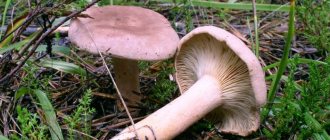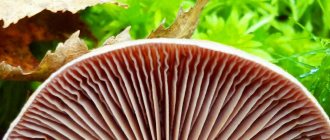Benefits of oyster mushrooms
Oyster mushrooms in the photo
In the wild, oyster mushrooms are common in Europe, America, and Asia. In China and Japan, oyster mushroom has long been widely used in national cuisine and is popular with the equally famous shiitake. In Russia, oyster mushroom is found in the middle zone, in Siberia, the Far East and the Caucasus. Oyster mushrooms grow here mainly in autumn and winter and tolerate winter temperatures well.
By the nature of their diet, oyster mushrooms are xylotrophic fungi from the group of saprophytes that feed on organic matter from decaying wood, so they prefer to settle on old stumps, dead trees, and dead trees. When describing oyster mushrooms, it is worth noting that these are predatory mushrooms, since they are able to absorb nematodes, first paralyzing them with the released toxin. Thanks to the mixed feeding method, oyster mushroom is able to replenish the need for nitrogen when there is a lack of it in rotten wood.
In industrial mushroom growing, mainly one type of mushroom is practiced - oyster mushroom, which is distinguished by its delicate taste and soft structure of mushroom fibers.
In appearance, the mushrooms have a one-sided, round cap. The cap can be flat or slightly concave. The culture does not have roughness and has a smooth surface. Diameter from 5 to 15 centimeters. Color from light gray to brownish. This mushroom has a white and dense small stalk or the stalk is completely absent. If you break it into two parts, the insides will contain pulp, which after a while becomes dense and fibrous. The pulp has a pleasant taste and aroma.
If, when describing oyster mushrooms, we talk about the benefits of these mushrooms, it is important to note that this mushroom contains a number of essential substances that are necessary for the human body to function normally. It contains proteins, fats, carbohydrates, vitamins and mineral salts.
Not even every dietary supplement can boast such a variety of beneficial substances.
People who watch their figure may not worry about the calorie content of the product. Oyster mushrooms have a low calorie content, which is only 38 calories. Even with a very small amount, a person can quickly and for a long time forget what feeling of hunger is. If we compare autumn oyster mushrooms with other plants, then in terms of the content of proteins and various amino acids they are on par with healthy vegetables, and the amount of fats and carbohydrates is several times higher than other products.
In terms of vitamin composition, oyster mushrooms have the same amount of vitamins B, C, E and D as meat. The product is not only the best food product that can be compared with various vegetables and meat, but also the best among valuable mushrooms. It contains a large amount of vitamin PP, which is not found in any other product.
Oyster mushrooms are not only a tasty food, but also an excellent fat-burning enzyme with low calorie content.
Oyster mushrooms beneficial properties
Most of the oyster mushrooms that go on sale are grown on a substrate of plant origin, so the mushrooms do not accumulate heavy metals and toxic substances.
In terms of taste, oyster mushrooms are compared to champignons; even, as some gourmets claim, they are superior when skillfully prepared.
You can eat oyster mushrooms only after heat treatment. Mushrooms are used to prepare soups, sauces, fry, stew, and marinate.
Oyster mushroom pulp contains a whole range of useful substances for the human body.
— vitamins
B, C, E, PP, D2
— such minerals
like calcium, iron, potassium, iodine
— amino acids:
threonine, leucine, valine, phenylalanine
Fat in the pulp
a small amount (a group of polyunsaturated fatty acids), they reduce blood cholesterol levels.
Carbohydrates
20% consist of fructose, sucrose, glucose, easily absorbed by the body, does not lead to fat deposition.
Polysaccharides
have an antitumor effect.
Oyster mushrooms are able to remove toxins and radioactive isotopes from the body. These mushrooms are low in calories
Therefore, they are actively used to combat excess weight.
Varieties of oyster mushrooms: photos and descriptions
Oyster mushroom (Pleurotus pulmonarius) . The mushroom is edible. The cap is up to 15 cm, fan-shaped, light, almost white, later yellowish or fawn, elastically fleshy, growing sideways from the tree. The plates descend on a short, dense white stalk. The pulp is fibrous, often saturated with water. The smell is pleasant, slightly aniseed. Spore powder is colorless. Oyster mushroom is a tree mushroom. Grows in deciduous and coniferous forests, in gardens and parks on birch, linden, aspen, and less often on coniferous trees. Fruits from July to September. It has no inedible or poisonous counterparts. It is cultivated or used for hybridization with other types of oyster mushroom to create productive varieties. Suitable for any method of culinary processing.
Oyster mushroom (Pleurotus ostreatus). The mushroom is edible. The cap is up to 15 cm, fan-shaped, dark gray in autumn at low air temperatures, light gray in warm weather, fleshy, growing sideways from the tree. The plates of this variety of oyster mushroom descend on a short, dense white stalk. The pulp is fibrous and dense. The smell is pleasant, slightly mushroomy. Spore powder is colorless. It grows in deciduous and coniferous forests, in gardens and parks on birch, linden, aspen, and less often on coniferous trees. In terms of the volume of mushrooms artificially bred in the world, oyster mushroom ranks second after bisporus champignon. Fruits from August to October. Sometimes it bears fruit in April, May, June. It has no inedible or poisonous counterparts.
Autumn oyster mushroom. It is an edible lamellar mushroom. Other names are alder oyster mushroom and willow oyster mushroom. It grows in large groups from the end of September until the frosts and first snow. Places of growth - trunks and stumps of deciduous trees: aspen, maple, alder, willow, etc.
Its surface is smooth and has a light mucous coating. Depending on where the oyster mushroom grows, it can be colored brown, gray or brown. On the underside of the cap of young mushrooms there are descending yellow plates, which in mature oyster mushrooms acquire a brownish tint. The mushroom stem is either very short or absent altogether. Thinner at the base, it has a curved shape and a finely scaly surface of a yellow-brown color. The pulp is dense, odorless, in damp weather it becomes watery, and in old mushrooms it becomes rubber-like. Oyster mushrooms are eaten fried, salted or dried.
Oyster mushroom. Oyster mushroom is an edible lamellar mushroom. It grows in large groups from the end of May to the end of October, preferring to settle on the stumps and dead wood of maples, oaks and elms. Extremely prolific, producing consistent, abundant harvests year after year.
Young mushrooms have a convex cap, but with age it changes and becomes horn-shaped or spade-shaped. Its diameter is approximately 13 cm. The surface of the cap is painted white or light yellow, which darkens over time and acquires a brownish tint. The plates are sparse, light-colored, descending along the eccentric lateral stalk. The leg is rounded, thinner at the base, white or fawn. The pulp of young mushrooms is dense, fleshy, has a pleasant aroma and good taste.
Oyster mushroom. Belongs to the fourth category of mushrooms. It can be boiled and fried; it is not suitable for long-term storage in salted or pickled form. Only young mushrooms are eaten, since old ones lose their nutritional value and are completely deprived of their good taste.
Lemon oyster mushroom. This mushroom differs from its other species in the multitude of fruiting bodies located on the joint. It is very loved by the residents of the Primorsky Territory and owes its name to the bright yellow color of its cap.
Steppe oyster mushroom. It does not settle on tree trunks, but in the ground, in the root zone of grasses belonging to the umbrella family, which makes it different from other species. This mushroom is most often found in the steppes and has dense and fragrant white flesh. It is traditionally distributed in the countries of Central Asia and in the Pamir and Tien Shan foothills.
Oyster mushroom is orange. It became famous as a beautiful mushroom, which became a decoration of gardens and forests. Settles on rotten stumps, dead wood, weakened birches, aspens and lindens. It grows both singly and in fan-shaped groups. The diameter of its cap reaches 7–8 cm. Orange oyster mushroom is edible only when it is young. An adult mushroom is inedible in most cases because it becomes tough and takes on the unpleasant smell of rotten carrots.
Young oyster mushrooms of this variety have watery, whitish or yellowish flesh:
The taste is bitter, and the smell is either melon-like or not noticeable at all. It is quite a common situation if a leg is missing.
Pink oyster mushroom. The second name is flamingo. Flamingo is one of the fastest growing. Already 10 days after sowing the mycelium, the first fruits appear. But this variety has its own characteristics: the mushroom is more heat-loving, and for the formation of fruits it needs a strict range of ambient temperatures from 16 °C to 30 °C. Ordinary grain straw, sunflower husks or buckwheat husks will be an excellent substrate for its mycelium.
Oak oyster mushroom. It grows mainly on oak trunks and stumps in July-August. The cap is up to 10 cm in diameter, regularly rounded, dense, fleshy, whitish, with dark fibrous scales, the edge is closed, with hanging white remains of the veil. The pulp is white, thick, dense, pleasant taste and smell. The plates running onto the stem are white; in old mushrooms they turn yellow. The leg is strongly eccentric, up to 5 cm long, 1-3 cm thick, white, scaly.
Autumn oyster mushroom
The cap of this species is quite dark in color. The mushroom has a lot of pulp. The outer side has a small layer resembling fine fluff. The leg has a lateral shape and is yellow-brown in color.
Fruiting of the mushroom begins closer to October and lasts until the beginning of winter.
Preparing the substrate for growing oyster mushrooms
Nowadays, people increasingly value food not only for its taste, but also for its environmental friendliness. For growing oyster mushrooms at home, it eliminates the content of nitrates and harmful substances. Oyster mushrooms have a beneficial effect on the human body, they are recommended for use by hypertensive patients, they reduce the risk of cancer, and normalize the level of lipids in the blood.
For the substrate, it is recommended to use straw from various cereal crops (barley or wheat). It must be clean and dry, free of odors and impurities. The straw of such crops is considered the most common raw material for these mushrooms.
When preparing a substrate for growing oyster mushrooms, straws must be chosen that are not infected, porous and wide. They need to be crushed or flattened. Straw should be purchased from one seller. If it is fresh and has a thick coating of wax, then it must be soaked for 12 hours.
At home, hydrothermal treatment is often used. Take a large container and compact straw into it. It is filled with warm water and then heated to 70 degrees. At a steady temperature, the substrate must be kept for about 3 hours, then drain the water. Next, the substrate is removed, removing excess water. When its temperature reaches 25 degrees, you can proceed to planting.
The straw cools down for about half an hour. During this time, you need to prepare the mycelium, a plastic bag, and the inoculation site. The substrate is poured onto the bottom of the bag, then a layer of mycelium is laid out. The procedure is repeated until the package is completely filled. Mycelium should be no more than 5% of the weight of the substrate.
Sometimes, in order to grow oyster mushrooms, sunflower husks are used. It must be heated very quickly to 90 degrees and kept for no more than 2 hours. Then drain the water, wait until the substrate drains (no more than half an hour), and then inoculate.
Growing these mushrooms at home is not that difficult. When breeding them, you should remember several rules. Firstly, the mycelium must be dispersed in such a way that 4/5 is located closer to the walls of the bag. Secondly, the number of layers should not be less than 12. A larger number will accelerate the fouling of the substrate with mycelium.
After compacting is completed, you need to leave a little space for tying. The block (a bag containing mycelium and substrate) must be left in a dark place at a temperature of 20 °C. If the temperature increases by more than 4 °C, the mycelium may die (inside the substrate the temperature can reach up to 35 °C).
If everything is done correctly, then after a maximum of 16 days the block will look like a white monolith. If some areas are infested, the overall yield will be lower. Until primordia appear, you just need to maintain the required humidity and temperature, and sometimes you can spray the block.
Video: Preparing substrate for mushrooms
Within two days, the primordia become adult mushrooms. As they grow, it is important to monitor the ventilation in the room. There is no need to water the mushroom buds, as this may cause their death. The harvest can be harvested when the edges of the caps at the top of the joint are aligned.
Below you will learn how to make oyster mushroom mycelium at home and how to grow mushrooms.
Gastronomic qualities of oyster mushrooms
Oyster mushroom is one of the most popular mushrooms consumed by humans. All types of oyster mushrooms are edible and have high gastronomic qualities.
In terms of taste and nutritional content, oyster mushrooms are no worse than more valued mushrooms, such as boletus mushrooms. It has a pleasant taste, slightly similar to anise or rye bread.
Oyster mushroom is resistant to cold, due to which it is distinguished by good yields and fruiting until the onset of frost. However, the mushroom has a rather fragile body structure, which requires careful handling during transportation.
Oyster mushrooms contain quite a lot of proteins and carbohydrates. The mushroom also includes various amino acids, polyunsaturated fatty acids, vitamins A, B, E and C, beneficial enzymes, fiber, mineral salts and other substances. In terms of composition, oyster mushroom is a very healthy and nutritious mushroom.
But, if you have diseases of the gastrointestinal tract, liver, as well as children under 7 years of age and pregnant women, they should not be used.
Mushrooms are consumed boiled, fried and pickled. Oyster mushrooms can be dried for long-term storage. Various alcoholic tinctures are made from oyster mushrooms.
- How is the competence center in the field of agricultural cooperation in Kostroma useful?
Homemade mycelium - growing mushrooms with your own hands. Step-by-step description of the technology for beginners (135 photos and videos)
Honey mushrooms at home - features of growing and keeping mushrooms. 115 photos and videos of honey mushroom growing technology
How to make oyster mushroom mycelium: growing it at home with your own hands
Oyster mushroom mycelium is the vegetative body of the fungus, mycelium, which consists of thin branched threads. Usually develops in the substrate or on its surface. There are several ways to obtain it, both in the laboratory and at home.
In nature, mushrooms reproduce primarily by spores. However, science does not stand still, and it was decided to learn how to grow mushrooms in artificially created conditions.
Previously, to grow oyster mushrooms in the forest, they took mycelium and propagated it in adapted greenhouses. At the same time, a small piece of it was planted on previously prepared soil, without sprinkling soil on top, so that the mycelium would not bear fruit. When all the soil was well intertwined with mycelium, it was taken out, slightly dried and used for dilution. In Russia, oyster mushroom mycelium was obtained in this way in the late thirties of the twentieth century.
The quality of the mycelium obtained under such conditions was low. Fruiting was scanty, and the mycelium quickly degenerated. When using such oyster mushroom mycelium, harmful bacteria and microorganisms were introduced, which inhibited development and deteriorated quality. Therefore, researchers were constantly looking for new technology for growing mycelium.
In 1894, in one of the institutes in France, mycelium was first bred from fungal spores grown in laboratory conditions. It had great prospects, since it took root much better and brought an extensive harvest before the mushrooms appeared in the forest. But spore breeding was successful only in laboratory conditions, which significantly reduced the frequency of its use.
The last to be patented was a method for growing oyster mushroom grain mycelium. In modern Russia it is still widely used. Mushroom growers grow mycelium on the grain of any type of cereal crop, as well as on sunflower shells, dry grape pomace, corn stalks, and sawdust.
The highest quality mycelium is obtained in laboratory conditions, but how can you prepare it at home yourself? If you do not have the equipment to organize the work of a scientific laboratory, then production at home can be carried out where there is gas, water and electricity.
You can prepare mycelium for growing oyster mushrooms at home, but before doing this, you need to purchase special equipment: test tubes, tweezers, thermometer, pipettes, agar.
At the stage of preparing the room and equipment, it is necessary first of all to take into account the fact that there are from 5,000 to 20,000 microorganisms per 1 m2. And the primary task for the mushroom grower is to resolve the issue of how to prepare sterile equipment and ensure workplace hygiene.
There are two ways to grow oyster mushroom mycelium at home. The first method is the full cycle. From spores or a piece of the fruiting body, a mother culture is grown, from which intermediate mycelium can be obtained and seed mycelium can be grown.
The second shortened method is the propagation of mycelium purchased from specialists.
Video: DIY royal mycelium
Oyster mushroom mycelium can be grown on grain or wood at home. Grain mycelium is obtained by applying mother cultures to a substrate of cereal grains. This type of production is more common.
In the second case, the mycelium is located on wooden sticks. This type is suitable when mushroom production on stumps is used. Mycelium grown on wood is less susceptible to diseases and has a long shelf life.
Mushroom recipes
There are many recipes for preparing Oyster mushroom. Let's look at some of them.
Cleaning
Cleaning oyster mushrooms is very easy. They grow on trees or are commercially farmed, so they usually have little debris. If you are cooking a lot of mushrooms, first soak them for 20 minutes in cold water. Remove any floating debris, then remove the mushrooms and rinse them under running water.
If there are only a few oyster mushrooms, simply divide them into portions and rinse well using a colander. Carefully inspect each mushroom, remove all damaged and dried parts.
Cut off the legs: they are very tough and therefore inedible. If you plan to freeze or dry oyster mushrooms, be sure to blot each mushroom with a dry cloth or paper.
In other cases, this procedure is also desirable.
Cooking
Cut the peeled oyster mushroom caps and boil for 15-20 minutes, 25 when cutting into large pieces. They are cooked in a pressure cooker for 8 minutes, in a slow cooker for 25-30 minutes, and for this method it is better to cut the mushrooms into strips. When boiled, they are used in pies and salads.
Boiled oyster mushrooms are stored in the refrigerator for 2 days, mixed with other ingredients and sauces - for several hours.
In the microwave, add a little melted butter to the water, mushrooms and salt at the bottom of the dish. They are cooked for 3 minutes at the lowest power, then stirred and cooked for 8 minutes at maximum. With any cooking method, mushroom broth can be used for soup or risotto.
Pickling
Sterilize the jars. Take 1 kg of oyster mushrooms. Disassemble the prepared mushrooms: large ones need to be chopped, medium and small ones can be left as is in this recipe.
Place them in a saucepan, add 600 ml of water, 2 tablespoons of salt and one of sugar. You can add 2 cloves of garlic and a bay leaf. When the mixture boils, pour 3.5 tbsp into it. l. 9% Art. l. vinegar (can be wine or apple).
Cook for 25 minutes. If foam appears, skim it off. Cool the mushrooms, transfer them to sterilized jars, fill them with marinade and put them in the refrigerator. In just a day, an excellent snack is ready.
Freezing
You can freeze both fresh and boiled oyster mushrooms. Prepare them, package them in portions and freeze. This semi-finished product can be stored for up to six months.
Frying
Prepared mushrooms are fried in vegetable or butter until the liquid evaporates (15-20 minutes), then simmer for another 5 minutes over low heat.
Pickling
There are several ways to pickle oyster mushrooms. They differ in technology. In any case, the finished product will be dense, crispy, with a sour taste and aroma of spices.
Salting “under nylon”. Prepare a kilogram of oyster mushrooms, cut into small pieces, rinse well in running water. Transfer to a colander. When the excess water has drained, place the oyster mushrooms in a saucepan, add cold water and cook for 15-20 minutes at high boil, then reduce the heat and cook the mushrooms for another 10 minutes.
Place the mushrooms in a colander again. While the water is draining, prepare the brine by pouring 250 ml of water, 40 ml of table vinegar, spices (for example, cloves and a little allspice), and a level tablespoon of coarse or sea salt into a pan.
Boil the mixture, pour the mushrooms boiled in water into the brine and simmer over medium heat for 20 minutes. The set of spices is optional and depends on your taste. Place the prepared mushrooms in glass jars, fill with brine, cover with nylon lids and store in the refrigerator.
Cold way. Prepare the mushrooms as usual. Cover the bottom of an enamel pan without enamel defects with coarse table salt, cover the salt tightly, in one row, place the caps upside down with the plates and add salt again. Select spices to taste.
A combination of fresh oak and cherry leaves gives an interesting effect, but you can also resort to a more traditional set.
Lay out the second row of hats. Salt it more densely and uniformly. Cover the workpiece with clean gauze, a earthenware plate on top, and place a weight. After 5 days, remove the weight and put it in the refrigerator. In a month the snack will be ready.
Canning for the winter
In addition to salting and freezing, pleurotus are preserved for the winter by frying and marinating for seaming:
- The easiest way is to fry oyster mushrooms. Boil the prepared mushrooms in two waters for 10 minutes, drain in a colander and let the water drain, cooling at the same time. Chop the oyster mushrooms and place in a preheated dry frying pan. When the liquid from the mushrooms has evaporated, add vegetable or animal fat and fry, stirring, for half an hour. You need to add salt at the very end. Place the resulting product in hot, dry, sterilized jars and fill with fat. If you choose animal fat, add a little salt on top after pouring. Roll up the jars and sterilize them in salt water for 1 hour. Then wrap it up and leave it to cool for two days.
- Classic pickled oyster mushrooms. Take a kilogram of oyster mushrooms, prepare them as described in the “Cleaning” section and chop them. Place mushrooms, peeled cloves of 1 head of garlic and spices to taste in an enamel pan without defects. In 750 ml of boiling water, dilute a dessert spoon of sugar and a heaped tablespoon of salt. Pour the resulting brine over the mushrooms, bring it all to a boil, add 70 ml of table vinegar and cook for half an hour. Place the prepared mushrooms in sterile jars, pour in the marinade and add vegetable oil on top until a thin film appears. Keep refrigerated.
- Spicy oyster mushrooms “Korean style”. For a kilogram of mushrooms, take a couple of medium carrots, 2 cloves of garlic, a tablespoon of salt, Korean vegetable seasoning, spices to taste, 80 ml of vinegar and vegetable oil. Peel the mushrooms, chop finely, and cook in salted water. While they are boiling, grate the carrots on a coarse grater and finely chop or pass the garlic through a press. Drain the boiled mushrooms well, mix the oyster mushrooms with vegetables and spices, add vinegar and vegetable oil. Place in sterilized jars and store in the refrigerator.
How to grow oyster mushroom mycelium at home (with video)
- Royal mycelium is obtained from part of the fruiting body. Fresh oyster mushrooms are cut into two parts and a piece is cut out from the top of the stem. Before replanting into the nutrient medium, a piece of the fruiting body is dipped in hydrogen peroxide to ensure sterility. After this, a piece of mushroom is placed over the flame into a test tube with a nutrient medium. The test tube is closed with a stopper fired over a fire. The cork cannot be placed on the table surface, so you must hold the cork and the test tube with your hands at the same time.
How to prepare a substrate for planting
After the mycelium has been prepared and crushed, you need to start preparing the planting soil.
For this use:
- Sawdust;
- Koru;
- Straw;
- Seed husks;
- Corn waste.
Important! Planting soil should not be moldy or rotten.
The prepared mixture is poured over with boiling water. Strain off the water and put the mixture under pressure. The mass should be small, so if you come across large pieces of bark or ears of corn, they need to be crushed.
Premises for growing oyster mushrooms
An old barn, a stone garage or a former pigsty can serve as a room for growing oyster mushrooms. The most important criterion when choosing a room for sowing oyster mushroom mycelium should be the ability to maintain high air humidity (85–90%) and maintain a temperature of 15 to 20 degrees, as well as the presence of a good ventilation system and proper lighting.
Oyster mushrooms do not like high temperatures; at temperatures above 25 degrees they will not bear fruit. Therefore, the use of greenhouses as a room for sowing oyster mushroom mycelium is unacceptable.
Mushrooms are sensitive to carbon dioxide. It is best to plant oyster mushroom mycelium when its level is low. Therefore, good indoor ventilation is the key to success.
The chambers where the seedlings are located must be illuminated. It is better if it is natural light, but it is advisable to avoid direct sunlight on the mycelium. If there are no windows in the room, fluorescent lamps are used for growing oyster mushrooms. Constant lighting is not necessary; 8–9 hours a day is sufficient.
How to set up a growing room?
It is best to use non-residential premises, basements of various houses, glazed balconies or even loggias from multi-storey buildings for growing these mushrooms. It is very important to observe a simple condition to prevent infection of the mycelium used.
The room with planted oyster mushroom mycelium should not come into contact with the growth site of the mushrooms. It is recommended to work with mycelium wearing gloves.
- Talker - description of the species, distribution of the species, benefits and harm + 79 photos
- Gall mushroom - description of appearance, seasonality, taste + 69 photos
Rizhik - where and at what time it grows, benefits, recipes + 90 photos
Technology for growing oyster mushrooms on stumps
To grow oyster mushrooms, you can use any cellulose-containing material: straw, sawdust from deciduous trees, and paper are suitable for this purpose. Existing methods make it possible to cultivate oyster mushrooms both in special premises and in summer cottages, as well as to grow mushrooms at home.
All methods of growing oyster mushrooms can be divided into extensive and intensive. Extensive methods include cultivation in natural conditions. Intensive methods involve growing mushrooms in special rooms where the appropriate atmosphere, lighting and humidity are maintained.
The stumps remaining after deforestation are perfectly suitable for growing. The mycelium is applied to the surface of the stump in a layer of 1.5–2 cm, having previously cut off a disk 3–5 cm thick. After placing the mycelium, it is covered with a cut disk, which is nailed down. This is usually done in April or May.
When grown on stumps, oyster mushrooms appear within 40–50 days; fruiting can occur in 2–3 waves. When cold weather sets in, mushrooms stop growing.
Video: Oyster mushroom on stumps
Growing oyster mushrooms on stumps using this technology in the country involves the use of grain mycelium for planting, which is applied in a layer of 1.5–2 cm to the clean front surface of the stump. After this, the stump is covered with a polyethylene film, and a layer of earth 10–15 cm thick is sprinkled on top and along the edges of the film. The most suitable time for growing oyster mushrooms on stumps in the country is the beginning of April. The consumption of seed material (mycelium) with this method is 1 kg per 10 stumps.
Where and how do oyster mushrooms grow in nature?
Mushrooms in nature
grow on organic remains of deciduous trees and shrubs (fallen trees, stumps, logging waste). Most often these are trees such as linden, aspen, oak, alder, but you can also find oyster mushrooms on birch, poplar, and chestnut trees.
Oyster mushrooms almost always grow in large groups of 30 or more. It grows on tree trunks one below the other, forming tiers or next to each other.
An effective way to grow oyster mushrooms on stumps
Planting of seed material can be carried out in a more effective way by introducing mycelium into pre-made cuts 3–4 cm deep, 5–6 cm wide, or drilled holes of the same depth and 1.5–2 cm in diameter. After inoculation, the cuts are covered with fresh sawdust, and the holes - wooden plugs. The ends are covered with plastic wrap and sprinkled with a layer of earth.
Growing oyster mushrooms on stumps lasts 3.5–4 months, then it is time to harvest. Typically, this period occurs at the end of September, when daytime temperature fluctuations are 12–18 °C, and nighttime temperature fluctuations are 3–7 °C, which is considered the most optimal for oyster mushrooms. Before fruiting begins, somewhere in mid-September, the stumps are removed from the film and earthen layer. Please note that growing oyster mushrooms requires high humidity. Therefore, in dry weather, the soil around the stumps should be watered up to three times a week.
After 5–7 years, fully fruited stumps become rotten and crumble. Growing oyster mushrooms in this way can be used as a natural method of removing stumps in gardens, parks, cottages and personal plots.
To grow mycelium, you can also use 25–30 cm long pieces left over from cutting down trees (the diameter of the pieces is at least 15 cm). They are placed in the basement in a column of 3–6 logs on the mycelium (70–100 g) previously wiped with a damp, clean rag in a layer of 1–2 cm. For better development of the mycelium and retention of moisture in it in the basement, columns of sections are covered with straw or breathable material , for example, burlap. When mycelium sprouts, excess carbon dioxide accumulates in the basement, so drafts should be provided for ventilation. In April, sections with mycelium shoots are planted in open ground.
Oyster mushrooms contraindications
Remember that the pulp of these mushrooms contains chitin, which is not absorbed by the human body. To destroy the structure of this substance, mushrooms are finely chopped and heat treated.
— it is impossible to completely get rid of chitin, so oyster mushrooms are not recommended for children under 5 years of age
- teenagers can eat mushrooms, but in small quantities and with caution
— allergy sufferers
mushroom spores, care must be taken during collection and preparation
- do not eat oyster mushrooms more than 2 times a week
, then they will benefit you.
The process of growing oyster mushrooms on wood
The technology for growing oyster mushroom mycelium on wood with your own hands is quite simple. Material for cultivating mushrooms is prepared in advance. The length of the bars is 25–30 cm; the side leaves and branches are removed from them. The wood is then cut into pieces and soaked in water for several days. At the beginning of spring, the pieces are placed in cellars or similar rooms. They are placed in columns that reach a height of 2 m. A layer of mycelium is applied to the upper end of each column. To maintain moisture, the mycelium is covered with a layer of straw. They can use matting or burlap, but not plastic film, as it blocks the access of air to the mycelium. The mycelium develops in wood within 2–2.5 months. You need to monitor the temperature and humidity in the room for better growing.
In summer, pieces of wood are moved outside. They are buried in the soil to a depth of 10–15 cm in a row. The end of the stump, where the mycelium develops, must be in the soil. After planting, the cuttings are watered abundantly.
Under natural conditions, the fruiting bodies of mushrooms fully develop in September or October.
Steppe oyster mushroom
Compared to most other varieties of this mushroom, steppe oyster mushroom does not grow on wood. The place where the fungus grows is the root system and stems of various plants from the umbrella family.
- How to properly dry mushrooms at home
How to store mushrooms - norms, rules, optimal conditions, how to properly grow, process and store mushrooms (100 photos)
Growing honey mushrooms - 95 photos and video description of the technology for growing the main species at home
Growing oyster mushrooms in bags with straw
Often at home, straw bales can be used to grow oyster mushrooms. In this case, the straw is not subjected to heat treatment or pasteurization, so this method is not used in mushroom production.
The substrate for growing oyster mushrooms in bags with straw must be fresh, without rot or signs of damage by microorganisms. Before use, it is moistened by immersing it in water for 80 hours.
Bags of straw are placed in places protected from direct sunlight: under sheds, in sheds, cellars, etc.
When growing oyster mushrooms on straw, the mycelium develops in 10–12 weeks, that is, if planted in May, the harvest can be harvested in September. In 2–3 waves of fruiting, 3–5 kg of mushrooms are obtained from one bale. The technology is not too complicated; this is a very good option for people who are interested in mushroom growing.
What time of year do they meet?
There are many types of oyster mushrooms that naturally grow from spring to late autumn. But the common oyster mushroom prefers cool weather, so its fruiting season lasts mainly from mid-September to the end of November . The first oyster mushrooms may appear at the end of May and in the summer if the weather is cold, reminiscent of autumn, for a long time.
Important! Peak fruiting of the oyster mushroom occurs at the beginning of October.
Growing oyster mushrooms in plastic bags
Disinfect the bag before planting. Since the bags cannot be boiled, place them in a 2% bleach solution for two hours. After disinfection, start filling the bags; you will need to put 5 kilograms of substrate in each bag, followed by a layer of mycelium. Strictly follow the order to the very top. After planting, make small slits in the bag to allow oxygen to enter.
During the first two weeks when growing oyster mushrooms in plastic bags, there is an incubation period. The optimal temperature for the growth and development of the product is from 18 to 22 degrees.
Do not allow the substrate temperature to exceed 30 degrees. The first three days after planting, the temperature inside the bags is quite high. You can reduce the temperature in the bag in a simple way: to do this, point a fan at the bag. The mycelium will not be harmed.
Video: How to grow oyster mushrooms
With proper lighting, you can leave the mycelium alone for the first three days after planting. After three days, small white threads will begin to make their way through the substrate. The next ten days will be spent filling the bag with mycelium. The mycelium will acquire a corresponding mushroom smell.
General characteristics of oyster mushrooms
Oyster mushrooms grow on stumps, fallen trunks or dying trees. It is better to look for them on birch and aspen, sometimes on poplars. In a garden or summer cottage, they are usually grown on a substrate made from plant residues: processed vegetables, straw, sawdust. Mushrooms of this genus prefer a temperate climate and love cool or even cold weather: they usually begin to grow in the fall.
Description of appearance:
- Dimensions: oyster mushrooms are usually quite large, their caps grow up to 30 cm, although they can be miniature - only 5 cm. Beneath them, asymmetrically located short legs no more than 3 cm long are almost invisible. The shape of the mushroom cap resembles an open oyster or an auricle with thin wrapped edges.
- The color of the cap and the fruiting body as a whole: depends on the age of the mushrooms and their belonging to a particular species. With age they often become pale or yellow. The spore powder is white or pinkish.
- Pulp: in young specimens it is soft and juicy, with a mushroom smell. Old mushrooms are inedible due to their hard flesh.
- Intergrowths: fruiting bodies often grow in numerous groups - bunches, forming unique multi-tiered “structures”.
State of BZHU: these data show the usefulness and dietary content of oyster mushrooms. They have high energy and nutritional value. Oyster mushroom cultivation is widespread due to the unpretentiousness and rapid growth of these mushrooms. A breeding farm can be set up in a garden or in an apartment. No special equipment is required to breed these mushrooms.
Technology for growing oyster mushrooms on grain
In the modern world, grain or royal mycelium of oyster mushrooms is used for the propagation of mushrooms. It is usually grown in sterile laboratory conditions to protect the mycelium from harmful microorganisms and increase yield. But amateur mushroom growers have found a way to create it at home. Moreover, homemade mycelium bears fruit no worse than laboratory one.
Mycelium using oat flakes. You will need to take:
- 40 grams of flakes crushed to a powdery state;
- 960 ml water;
- 100 grams of gelatin;
- bactericidal lamp;
- sterilized test tubes and cotton plugs for them;
- grain cans, tweezers;
- mature oyster mushroom.
Oatmeal must be boiled for an hour, then strain through several layers of gauze. Soak the gelatin in water (take some from the already prepared water) and, when it swells, heat it in a water bath, then add it to the oatmeal jelly. Fill the test tubes with the resulting slurry to 2/3 of the total volume, close with cotton plugs and place to sterilize in a water bath for 40 minutes. Next, you will need to install the tubes in an inclined position so that the inoculation area becomes larger. When the substance in the test tubes has cooled, use sterilized tweezers to take an oyster mushroom plate (the part that grows under the mushroom cap) and carefully place it in the test tubes on the nutrient medium. Close the test tubes with cotton plugs and wrap them in foil. Place the tubes in a dark place with a temperature not lower than 24 °C. After 2 weeks the mycelium will be ready.
Such mycelium will need a grain substrate. To prepare it you will need:
- 10 kg of grain (any grain crop);
- 15 liters of water;
- 130 g gypsum;
- 30 g chalk.
Boil the grain in water until it becomes soft, but do not boil it into porridge. Dry the boiled grain well and add gypsum and chalk to it. Fill the jars with the prepared grain, making a small depression inside to place the mycelium in the future. You need to make a hole in the lids with a diameter of 1.5 cm, and then close the jars with them. Plug the holes in the lids with cotton swabs. Sterilize in the oven at 120°C for two hours.
Now all that remains is to plant some oyster mushroom mycelium in the prepared grain substrate. It is necessary to slightly heat the test tubes with the mycelium ready for planting so that it can easily separate from the walls. Using sterilized tweezers, carefully transfer the oyster mushroom mycelium from the test tube into the depression prepared on the grain. It is important to close the holes in the lids again with cotton plugs and place the jars in a dark place and remember to maintain the room temperature at 24 °C. Maintaining sterility when growing oyster mushrooms on grain is very important in the entire procedure from beginning to end. Only in this case will the mycelium produce high yields for a long time.
Video: How to make mycelium from grain
Oyster mushrooms in folk medicine
Depressant
Grind about 50 g of oyster mushrooms and pour a bottle of Cahors. Leave in a cold place for 7 days. Take 30 ml before bedtime.
Prevention of thrombophlebitis and atherosclerosis
Process fresh mushrooms with boiling water and chop very finely (to the consistency of a paste). Take a tablespoon 3 times a day for 14 days. Repeat after 2 months.
Medicine for hypertension
Pour chopped oyster mushrooms (about a quarter cup) into a glass of vodka. Infuse for 14 days in a cool, dark place (shake daily). Take a teaspoon before meals. The course of treatment is 2 weeks.
Methods for storing oyster mushroom mycelium
Today, there are two known ways to store oyster mushroom mycelium. Both of them are usually used in large industries. This is storing the mycelium in the cold and placing it in liquid nitrogen.
The first method involves placing oyster mushroom mycelium in the refrigerator. The disadvantage of this method is the difficulty in recognizing the active structure. Therefore, before use, the mycelium is removed from the refrigerator, shaken vigorously and left at room temperature for several days. Active mycelium will begin to grow rapidly, while spoiled grain will remain bare and its color will be unpleasantly brown.
A more advanced way to preserve oyster mushroom mycelium is to place it in liquid nitrogen. In addition to the fact that this substance allows you to well preserve the structure in which oyster mushrooms will grow in the future, it has a beneficial effect on the quality of the final product and on the productivity of the mycelium.
Before storing the mycelium, it is kept for several days at a temperature of about 5 degrees Celsius. The freezing process itself is carried out very slowly and under careful control. Before planting, the mycelium is slowly defrosted.
As laboratory experiments show, it is best to store mycelium in liquid nitrogen, since with this method practically no changes occur and all its properties remain almost the same as before storage.
At home, storing mycelium is best done in a freezer with a temperature of minus 20 degrees Celsius. As the practice of experienced mushroom growers shows, such storage makes it possible to obtain good quality material by the required date without any significant changes. After a short period of rest, when the mycelium is at room temperature, the structure continues to vegetate.
Only repeated changes in temperature conditions, which result in thawing and re-freezing of the material, can lead to a deterioration in its quality, which, of course, does not contribute to the high yield of oyster mushrooms. Therefore, it is very important for the mushroom grower to ensure a stable temperature for the stored mycelium, regardless of environmental factors and conditions. Especially if mushroom production is on stream and is the main source of income.
Getting oyster mushroom mycelium at home is the dream of any mushroom grower. Nowadays it is not difficult to buy it. However, it is not always possible to find a company that is 100% responsible for product quality. The fact is that such organizations work mainly with wholesalers and practically do not have time to monitor quality in such conditions.
You can find out that the product is “inoperative” only when the bags with the substrate turn green. But growing oyster mushrooms requires a certain amount of time, and 40% of the cost goes to the substrate. In this case, mushroom growers, not trusting unknown producers, grow mycelium with their own hands.
False look-alikes of the oyster mushroom
There is only one truly poisonous mushroom similar to the oyster mushroom - Omphalotus nidiformis, and it grows in Australia.
Omphalotus nidiformis
Among domestic mushrooms, sawfoils are similar to oyster mushrooms, among which there are both edible and inedible species. But most similar to oyster mushrooms is Sawfoil. Like all of its relatives, it, unlike oyster mushrooms, has jagged, broken plates. Although not all of them have such characteristics. Sawfoils are much less common than oyster mushrooms. Found from July to September-October.
They have a caustic, bitter, extremely unpleasant taste. This is its only harm. If you doubt whether this is the one in front of you, break open the mushroom and smell it. Unlike the odorless oyster mushrooms, sawfoil has a distinct mushroom smell.
Another similar species, the whole harm of which is its ability to spoil the dish, is the bear's sawfoil. It differs from oyster mushrooms by obvious multiple notches on the plates and an unpleasant odor of the pulp.
Wolf's sawfoil
Orange oyster mushroom is relatively edible, but it is too tough and will not add any charm to your culinary masterpiece. It not only looks like an oyster mushroom, but is also a close relative of it.
However, its beautiful orange cap eliminates any doubts about the suitability of this mushroom for food. But it can perfectly decorate a summer cottage and is even cultivated for this purpose. But the green oyster mushroom is not cultivated: it is ugly.
And they don’t cook it again because of the bitter taste. But it is simply impossible to confuse its greenish cap with the gray, purple and light yellow caps of ordinary oyster mushrooms.
Oyster mushroom orange
Oyster mushroom harvest
These mushrooms ripen in clusters. When harvesting oyster mushrooms, they are twisted out of the substrate or cut off at the base so as not to damage the mycelium. After 10–15 days, the second wave of the harvest appears.
During the fruiting process there can be up to four waves of harvest, but the largest number of mushrooms are collected during the first.
After fruiting is completed, the mushroom blocks are removed, and the growing room is disinfected with a chlorine solution, closed for several days, and then thoroughly ventilated. Then you can download a new batch. You can perform up to four such cycles per year.
- Author: Tatyana
Rate this article:
- 5
- 4
- 3
- 2
- 1
(12 votes, average: 4.2 out of 5)
Share with your friends!
The nutritional value
Oyster mushrooms are an incomparable source of protein and B vitamins. In terms of the concentration of niacin (vitamin B3), these mushrooms are the leader among all food products: 100 g contains at least 500 percent of the recommended daily intake.
And as a source of iron, these mushrooms are much better than red meat or poultry. In addition, oyster mushrooms provide the body with vitamin D, which is essential for bone health. Nutritional properties (per 100 g of fresh mushrooms)
| Calorie content | 33 kcal |
| Squirrels | 33 g |
| Fats | 0.4 mg |
| Carbohydrates | 6,4 |
| Copper | 0.4 mg |
| Iron | 2 mg |
| Magnesium | 25 mg |
| Manganese | 0.2 mg |
| Phosphorus | 175 mg |
| Potassium | 620 mg |
| Selenium | 3.5 mcg |
| Zinc | 1 mg |
| Folic acid | 40 mcg |
| Niacin | 7 mg |
| Riboflavin | 0.5 mg |
| Thiamine | 0.2 mg |
| Pyridoxine | 0.1 mg |
Making a substrate
Before growing oyster mushrooms, it is necessary to prepare a substrate that will protect the mushrooms from mold formation. Experienced mushroom pickers use wood shavings for this. For beginners, it is easier to use sunflower seed husks or dry corn stalks.
The material must be heat treated (using steam or boiling), then cooled and crushed. Pack the resulting mass in plastic bags with holes and place in a clean and warm room.
The final stage
After 20-24 days, the packages can be moved to the basement or to the balcony, where they can be hung from the ceiling at a distance of at least half a meter from each other.
Required lighting - 5 W/sq. m. Water for irrigation should have a temperature from 10 to 25 degrees and flow from top to bottom once, maximum - twice a day.
If the conditions are met, the first harvest can be obtained in a month and a half. The second one will appear in 20 days.
